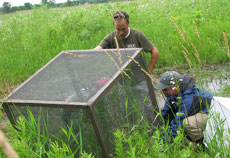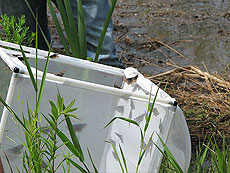| Tuesday, July 5, 2011 |
| Subscribe | Contact Fermilab Today | Archive | Classifieds |
Feature
|
Butterflies released into Fermilab's natural areasFermilab is the new home to Baltimore checkerspot butterflies, released by scientists from Chicago's Peggy Notebaert Nature Museum late last month. Native to North America, Baltimore checkerspot butterflies once thrived in wetlands in the northeastern and Midwestern regions of the United States. A steady decline in natural habitats has made them an imperiled species, at risk of becoming endangered. In 2009, the nature museum made its first attempt to introduce the butterflies to Fermilab's wetlands. Museum staff placed Baltimore checkerspot caterpillars onto their host plant, white turtlehead, which Fermilab volunteers had grown on site as part of the ecological land management program to enhance Fermilab's wetlands with native plants. But the larvae didn't survive the winter. The caterpillars that hatch from one egg mass typically spin a hibernation web and spend the winter together. Perhaps releasing them individually kept them from properly building their winter shelter, said Doug Taron, curator of biology at the nature museum. This year the museum staff took a new approach: instead of caterpillars, they brought adult butterflies. In addition to releasing most of them into the open prairie, they placed a few butterflies in screened cages together with the turtlehead plants to increase the chances they would lay eggs on the plants. The cages were built a few years ago by Matthew Wischoeffer as part of an Eagle Scout project with Fermilab. On Thursday, June 23, a windy and rainy day, Taron, along with the nature museum's director of arthropod conservation, Vincent Olivares, and a group of conservation workshop attendees, came to Fermilab to release the butterflies. Taron and Olivares placed two females and one male in each of three large cages. When the remaining butterflies didn't emerge from their transport container, Taron explained to onlookers that it was too cold. They decided to take the rest of the butterflies back to the museum and wait for a warmer day. They succeeded in releasing the butterflies on Saturday, June 25. About 70 butterflies fluttered out into the prairie between inbound and outbound Pine Street. The effort has set the stage for the next generation of Baltimore checkerspots. Just a few days after being placed in the cages, the butterflies had already laid eggs on the turtlehead plants, said TD's Tom Peterson, Fermilab's local butterfly monitor and member of Illinois Butterfly Monitoring Network. "These eggs should hatch in a week or two. Then the tiny caterpillars will eat and grow until fall and then spend the rest of the year hibernating," Peterson said. The next generation of adult butterflies should emerge sometime next year. Ryan Campbell, Fermilab's natural resource specialist, explained the significance of releasing butterflies on site. "It's another piece of the puzzle, increasing the complexity of food webs and restoring biodiversity at Fermilab, especially at wetland sites," Campbell said. — Christine Herman |

